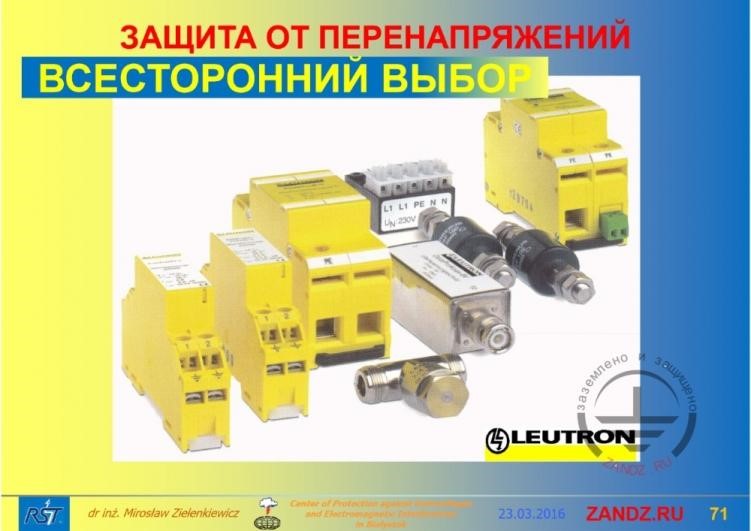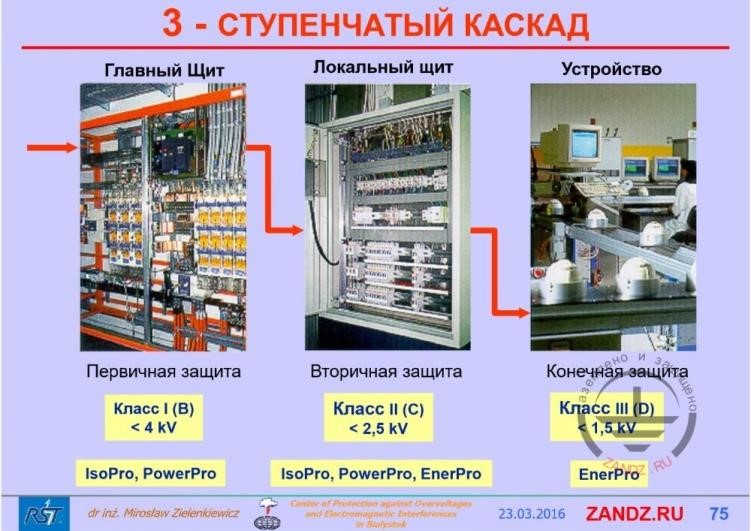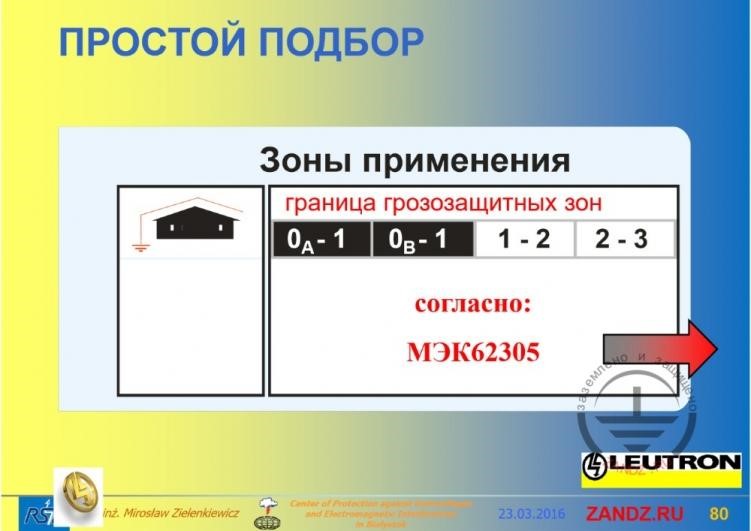The second Webinar from the series "Surge protection"
Webinar text. Page 5
Quick navigation through slides:
<< Page 1:
1. Surge protection for power lines 230/400 V 50 Hz Part 1
2. About Miroslav Zelenkevich
3. Main circuit of enabling surge protection elements
4. Cascade protection circuit
5. SPD – the main protection circuit
6. Gas-discharge and semi-conductor devices
7. Spark air gap
8. Forms of gas-filled electrodes
9. Picture of two electrodes
10. Picture of railway line
11. Spark arresters of old type
12. Coal arresters
13. Why coal
14. customer line connection circuit
15. Coal arresters’ operation principle
<< Page 2:
16. Protection of pole-mounted transformer substation
17. Gas arresters of 6 kV line
18. Construction of gas arresters
19. Additional protection element
20. Characteristics of protection element
21. Advantages of gas discharge elements
22. Gas filled arresters
23. Railway arresters
24. Construction of gas filled arresters
25. Gas filled arresters of minor energy
26. Cross section of an arrester
27. Arrester in direct current circuit
28. Arrester in alternate current circuit
29. Sine-wave voltage impact on an arrester
30. Arrester - pulse dialling
<< Page 3:
31. Residual pulse, missed by the arrester
32. Maximal voltage value
33. Discharge action steps at the protection of a device
34. The main parameters of arresters Part 1
35. The main parameters of arresters Part 2
36. The main parameters of arresters Part 3
37. Advantages of gas-filled arresters in low-frequency circuits
38. Example of electrical parameters of a 3- electrode arrester
39. Disadvantages of arresters in low-frequency circuits
40. Lightning current arresters
41. Arresters with arc division
42. Approximate parameters of arresters
43. Main application conditions for surge protection purposes
44. Dynamic pick-up voltage
45. HF and SHF elements
<< Page 4:
46. Semi-conductor surge protection elements
47. Variable resistors
48. Characteristics of U-I variable resistor
49. Structure of ZnO – variable resistor
50. Sizes of ZnO – variable resistor
51. Mono-crystal lattice
52. Three areas of volt-ampere characteristics
53. Advantages and disadvantages of ZnO variable resistors
54. Parameters of variable resistors Part 1
55. Parameters of variable resistors. Part 2
56. How to choose a variable resistor correctly?
57. Protective diodes.Types
58. Protective diode on an example of TRANSIL device structure
59. Designed diodes
60. Response characteristics
Page 5:
61. Types of protective diodes by the execution method
62. Advantages of protective diodes
63. Disadvantages of protective diodes
64. Protective diode operation stages
65. Protected device surge resistivity
66. Detector input circuit protection
67. Line repeater of phone line communication protection
68. All-round choice
69. Special purposes in surge protection of circuits
70. Low-voltage electricity supply surge protection
71. Arrester’s connection circuit in a construction project
72. Steppable cascade
73. Electricity supply network surge protection
74. Dynamic pickup voltage
75. Questions and answers
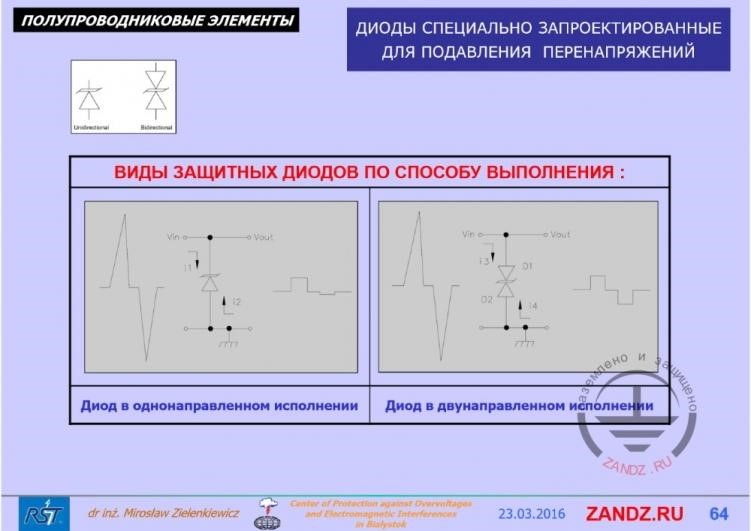
Types of protective diods by the execution method
Полупроводниковые элементы – semiconductor elements
диоды специально запроектированные для подавления перенапряжения – diodes specially designed for suppressing overvoltages
виды защитных диодов – types of protective diodes by the execution method
диод в однонапрвленном исполнении – diode in one-direction execution
диод в двунаправленном исполнении- diode in two-direction execution
- In practice we face two forms, they are indicated here. That is, an uniderectional diode and duodirectional, in this case such a set will protect fro two polarities of the pulse.
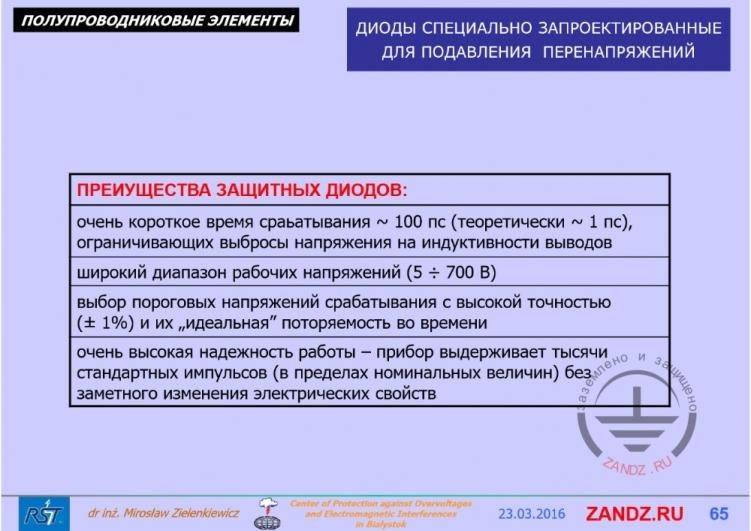
Advantages of protective diods
Полупроводниковые элементы – semiconductor elements
диоды специально запроектированные для подавления перенапряжения – diodes specially designed for suppressing overvoltages
advantages of protective diodes:
very short response time ~ 100 ps (in theory ~ 1 ps), limiting the emissions of voltage to the outputs’ inductivity
wide range of working voltages (5:70 V)
choice of threshold response voltages with high accuracy (+ - 1%) and their “perfect” repetition in time
very high work reliability – the device supports thousands of standard pulses (within the nominal values) without a noticeable change of electric properties
- Advantages of protective diods - it is a very short response time, about 100 ps as producers mention, that is 1/10 ns, and in theory ps, which limit voltage surges on the inductivity of these diods outputs. Wide range of working voltages from 5 to 700 V, which you can find in the catalogues of good companies. Here it is very important that the choice of threshold pickup voltages we make with a great precision event with ± 1%, please compare 20-40% at arresters and their perfect repetition in time is crucial. Very high operation reliability, such a device stands thousands of standard pulses in the frames of regular values without a significant change of electric features of this device.
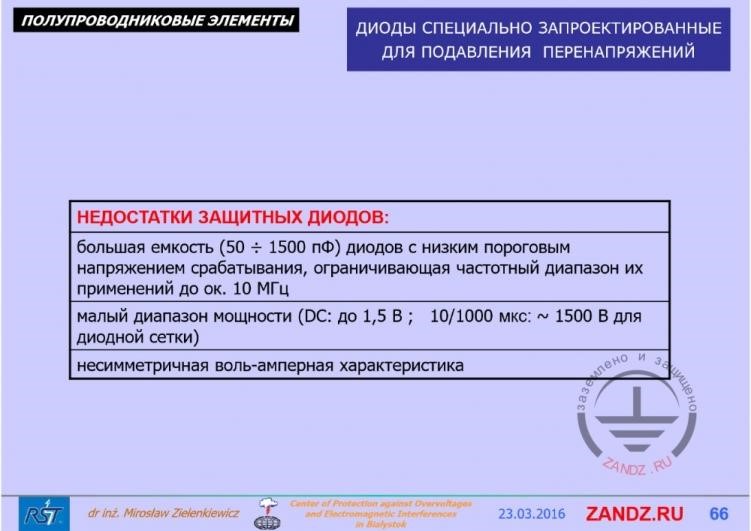
Disadvantages of protective diods
Полупроводниковые элементы – semiconductor elements
диоды специально запроектированные для подавления перенапряжения – diodes specially designed for suppressing overvoltages
Disadvantages of protective diodes:
Large capacity (500:1500 pF) of diodes with a low threshold response voltage, limiting the frequency range of their application to about 10 MHz
Small power range (DC: to 1,5 V; 10/1000 ms: ~ 1500 V for a diode mesh)
Non-symmetrical volt-ampere characteristics
- Disadvantages - it is a small capacity of diods, it increases the range of about 10 MHz, and then we have to supplement such a circuit with low-capacity diodes, that do not stand such great energies, as a specially executed diod. Small power range and unsymmetrical volt-ampere characteristics. These are the main disadvantages which we have to consider.
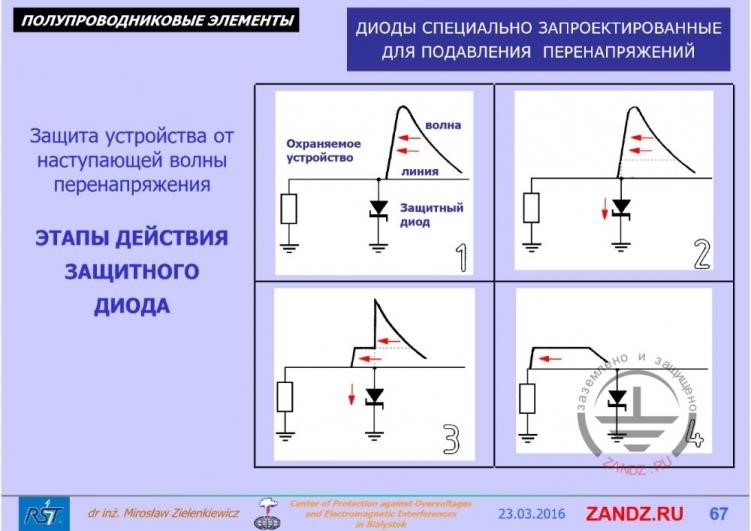
Protective diod operation stages
Полупроводниковые элементы – semiconductor elements
диоды специально запроектированные для подавления перенапряжения – diodes specially designed for suppressing overvoltages
- защита устройства от наступающей волны перенапряжения - Device protection from the coming overvoltage wave
Этапы действия защитного диода - Stages of protective diode actions
охраняемое устройство- Protected device
волна Wave
Линия- Line
Защитный диод- Protective diode
- For comparison I drew a similar picture to better remember how this element operates. We see that in this case no surge comes to our device. In practice there is a band, but if we look well, we can see some surge on nanosecond short pulses, but in practice they do not have great significance. These problems mainly arise in military applications. In our device, a well-cut band of low-voltage pulse voltage moves, it is safe for our device. It was not so with the arresters where a great pulse came to our device, if you remember.
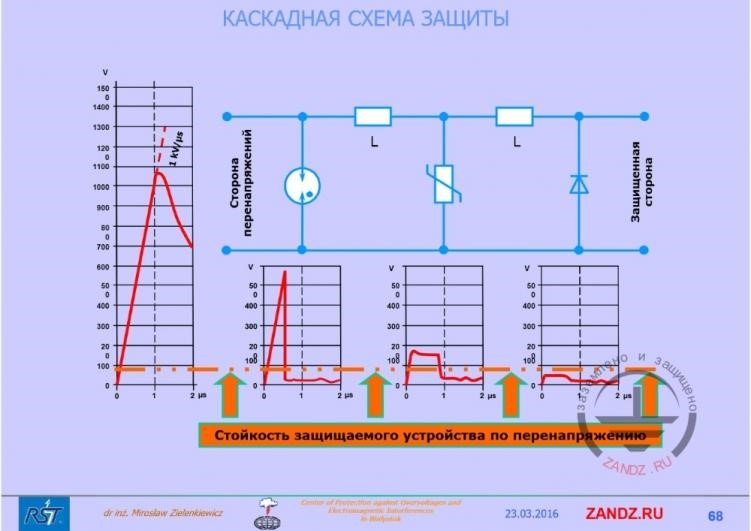
Protected device surge resistivity
Каскадная схема защиты – cascade protection circuit
Сторона перенапряжений – side of overvoltages
Защищенная сторона – protected side
Стойкость защищаемого устройства по перенапряжению – resistance of the protected device to overvoltage
- Let's look at the chart I've mentioned in the beginning. We will consider the limit parameters, which our element introduces. I think it confirmes what I've said one more time. Let a pulse get into our circuit, it grows with the speed of 1 kV/ms, we are interested in the front, because we should study this pulse on the front. So the front of this pulse is about 1 ms and if we stick to what I've said before, then the final element - diod will response first. Here it activates conventionally at the surge of 50 V.
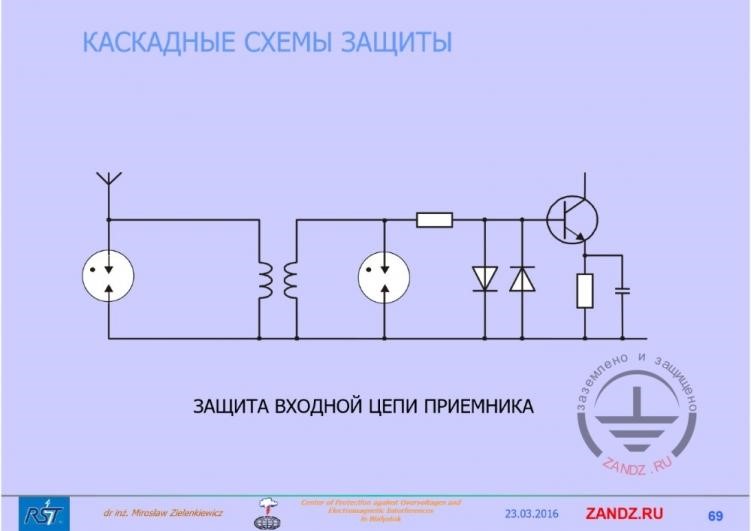
Detector input circuit protection
Каскадные схемы защиты – cascade protection circuits
Защита входной цепи приемника – detector input circuit protection
-In practice we face it in many cases. I took these charts from some Russian books when defensing my candidate's thesis. Here we see a cascade of the protective receiving terminal. One arrester on the left, inductivity here, additional arrester, diods, some mating component - it may be resistance, may be capacity.
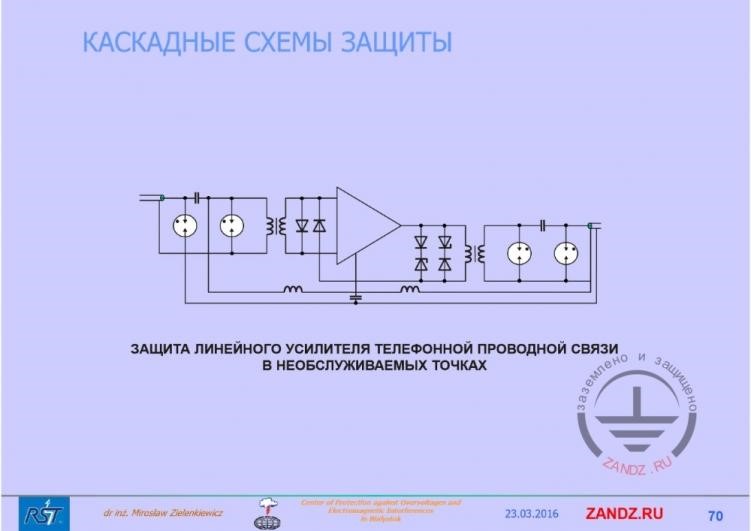
Line repeater of phone line communication protection
Каскадные схемы защиты – cascade protection circuits
Защита линейного усилителя телефонной проводной связи в необслуживаемых точках – line repeater of phone line communication protection in nonserviceable points
- Usually we often meet repearters of telephone wire connection because the cables are long and surges are immense. Two arresters have been long used for these cables. The capacity, which cuts the constant component, we don't need it, it cuts a great part of energy in case of a lightning pulse. And at the entry this repeater is also protected by additional diods on both sides.
Surge protection
All-round choice
- Let's move on to the electrical network protection. We will talk on the example of one company, "LEUTRON", which we represent, showing why we chose this company and why we recommend it, but we will focus on the parameters of these elements. The ways of choosing them in different situations and will concentrate on practical examples, because I listen to the explanations of many companies. I have an opinion that in many cases the questions is not to apply a good element, but to sell it. During the operation of our company we changed this principle. I asked the manufacturer about technical parameters and also ways of including the elements into the object, but did not get any reply. I decided that these companies do not want to give their information. If we dont know how this element functions, we do not believe in its reliability. Let is be a very famour company, it doesn't really matter for us. This is why our reports appeared.
Another standard, the third one, the fifth, you need to concentrate on some knowledge and stick to it, because in practice we see that another approach looks fantastical.
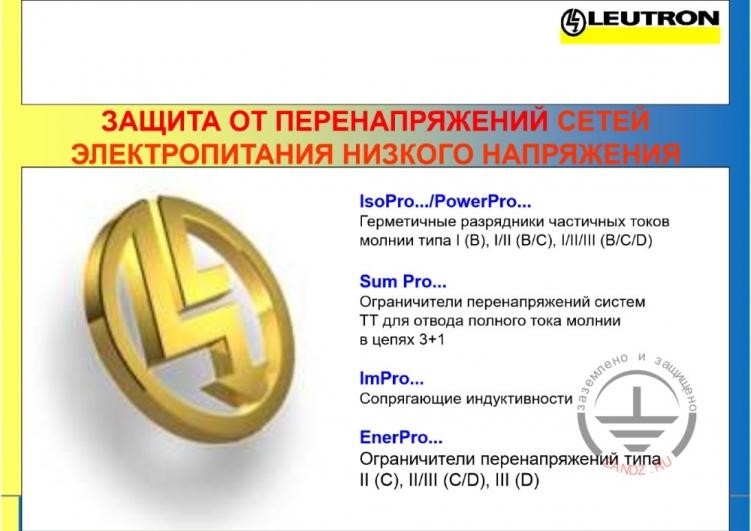
Special purposes in surge protection of circuits
Surge protection of power supply low voltage networks
IsoPro – hermetic dischargers of partial lightning currents of type I(B), I/II (B/C) , I/II/III (B/C/D)
Sum pro- surge arresters of TT systems for draining complete lightning current in 3+1 circuits
ImPro – conjugated inductances
EnerPro – Surge arresters of type II (C) , II/III (C/D), III (D)
- So if we look at these elements. "LEUTRON" company has special purposes in surge protection of low-voltage power circuits; they are called "PowerPro", "IsoPro", where we have elements of the first type or first category. We have "EnerPro" elements, which limit voltage; they can be of the 2 and 3 class. But this company is different from the others, because it was one of the first, or even the first, to introduce the so-called elements with different protection elements, that is, first, second class; second-third; third and that is why we'ce contacted this company.
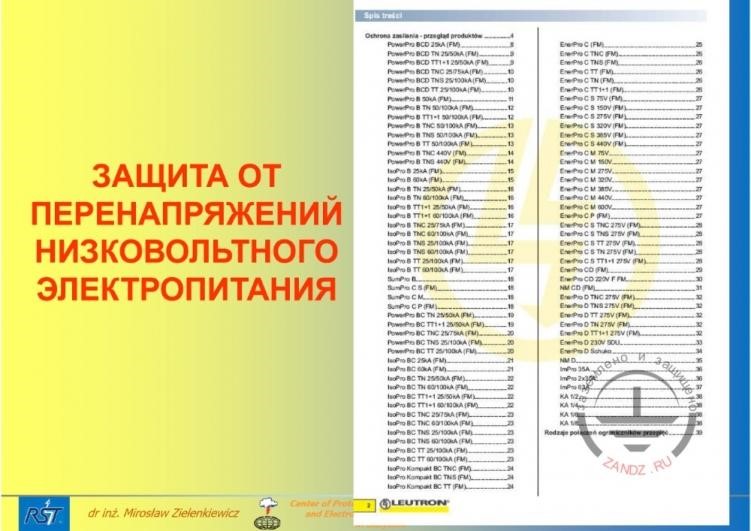
Low-voltage electricity supply surge protection
- There are many elements; I will try to tell you the main things. It will be in the next report and today I want to tell you the main things.
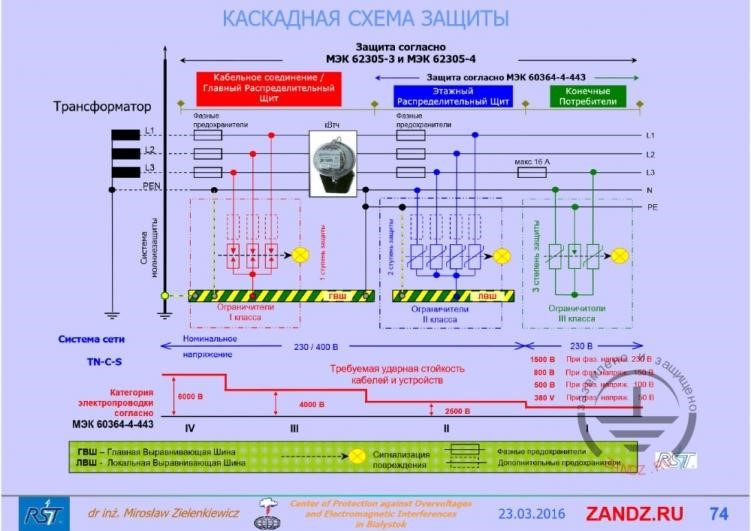
Arresters connection circuit in a construction project
Cascade protection circuit
- Let's look at the connections circuit of our elements in a construction object, I will tell you what standards solve this and why it happens so. I never heard such an explanation; it comes from my practical experience. Let's see because you can enlarge this diagram. On the left we see external power supply of a transformer station of our object. The object is powered by three cores, that is in this case there is TN-C power supply system and it shifts to TN-S system, running inside the object somewhere in the main switchboard on the bus, PN bases on wire N and wire PE. But we understand that this division significantly improves the safety of human life, because working currents flow only via phase conductors and return to the transformer by the same way. All body frames of the devices are connected to PE and the working current flows through them, which flows back to our transformer. On the object which has lightning protection system, it is indicated here. Here we see that all equipotential bonding systems are connected inside the objects. The main bus and the local buses in the boards all over the object. At the entry into the object, we install elements with a gas gap, not variable resistors, because they are able to drain the partial lightning current, flowing through these elements, when the potential on the ground electrode appears. This current will necessarily flow in our circuit and will flow to the transformer. The next cascade is variable resistor; it appears when the level of surges missed by these elements and the first cascade is too high. Let's see what means too high? Below I showed categories of cabling according to IEC 60364-4-443, which should possess certain resistivity which is indicated here.
That is why, I always install the third stage in such places as entry to the server room, to the room of systems monitoring etc. Where these devices are very sensitive. At the next seminar we will talk that our first element may possess the voltage of 2,5 kV or 1 kV, it is our choice and the topic of our next meeting. If we look attentively at our image, we will see that I put a lamp into each of them. What does this lamp mean? This lamp means, our company knows that if this variable resistor comes out of service, according to the requirements it will be disabled in order to avoid fire. In this case nobody notices that our variable resistor doesn't function. We will surely talk about it later. They have local indication of this state, for example, a green cat disappears, appears a red window. But question: will electricians monitor these variable resistors constantly? And who will look into the board to detect it? Nobody will do it ever, because nobody has time. We always put a lamp on the board wall or connect indication system, computer system of object surveillance. And the person sitting in the control toom knows that it depends on the precision, necessary precision of indication, that in this board on that floor some protection element is out of service. But we will talk about it at the next seminar.
3-stage cascade
Главный щит – main board
Локальный щит – local board
Устройство - device
первичная - Primary protection Class I
вторичная- Secondary protection – Class II
конечная - Final protection – Class III
- The primary protection is installed at the entry of the cables into the object. It is either the main switchboard or a place with a large board at the entrance. Secondary protection is installed in local boards on the next floors. You see in the bottom, which elements we will discuss at the next webinar. And final protection - third class elements - "EnterPro" elements which service for the restriction of current reduction.
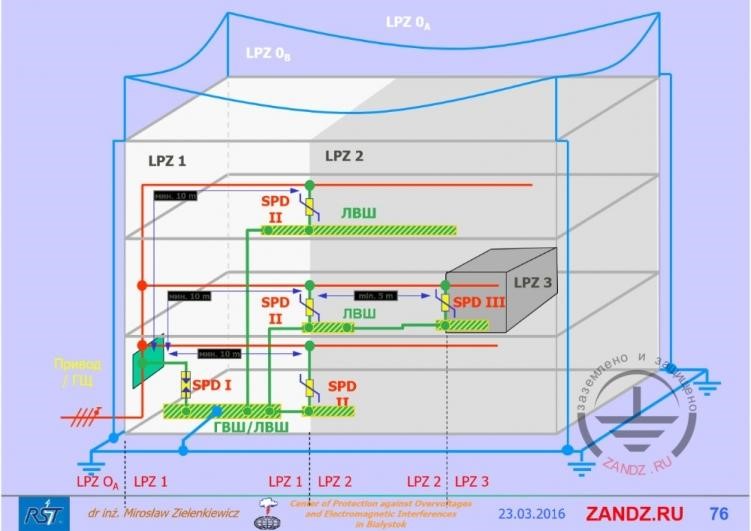
Electricity supply network surge protection
- If we look at our protection, we see that we need to correspond to the surge protection in electric supply network also for the zonal protection concept. I see I took a lot of time, and I think we need to finish my report for today. Though I have a couple of slides more but I am not sure you have so much time today. Let's postpone if for the next time, I have around 10 slides. If possible, dear colleagues please ask your questions because I can talk a lot and will take too much time. We can really discuss it at the next seminar. Alexey, can you hear me?
- Yes, Miroslav, I can. I completely agree with you that we need to fold up, we've exceeded the limit but anyway, thank you for the report. Everything was so interesting and clear. Like I've said and liek Miroslav said it is an introductory webinar. Here we explain general principles, differences of protection devices. We will switch to the protection of power supply circuits at the next webinar next week. Today we have a minute or two, so if you have any questions, please send them to the chat and we will try to answer them quickly. You can send the rest questions to our email adress which I will repeat in the chat now. I also offer you to sign up for our next webinars. I can see the first question from Dmitry. Miroslav, will you read it or shall I?
- I don't see it.
- OK I will read it then. It comes from Dmitry. It is in the bottom of the chat. "Miroslav, coming from your experience, how many and what SPDs should be enough for a single-family houses, for a warehouse or a hypermarket. And how external lightning protection will influence your choice. Or we will see it at the next webinar?"
Простой подбор- Simple selection
- зоны применения - Application zones
Граница грозозащитных зон - Borders of thunder protection zones
Согласно МЭК - According to IEC 62305
- Yes, we will surely study it next time.
But as you see, we have many doubts which should be explained, and I don't think these two webinars will be enough. But today I would like to answer this way - it will be enough.
Questions and answers
- Miroslav, I think it will be enough. We will wait for the comment from Dmitry. Now I offer to switch to the next question. We have two of them. The second question from Alexey Vadimovich: "Please tell if there is a difference in choosing SPD for electric equipment, which is located in LPZ0b at the insulated lightning protection and non-insulated?". This question is in the general tab below.
-Yes, I understand. Frankly speaking, I see no difference. We need to understand that lightning protection systems can't allow for the partial lightning current to jump from lightning rods to the systems which we covered from the strike. If we did everything properly, it doesn't mater for me if the system is insulated or not. We put the same elements at the cable entry into the object. We only have to consider the length of cables in the parallel lightning protection system and what surges can induce in it. So that's what I do in real life. We need to understand, that in case when such cables go outside, they should be shielded. You will find it in IEC 62305 3 and 4.
— Thanks for your answer, Miroslav. Another question, if we can get an answer in 1-2 minutes on it, it would be great. We simply have no time at all. Question from Sergey: "Miroslav, we need to protect computers from overvoltages and lightning and equipment which is installed in the open cast with iron-oxide soil. What can you advise?"
- What soil?
-Iron-oxide.
- I don't think it makes sense what type of soil, because as I get it, iron oxide is a very good conductor. I don't think it matters what soil is there, but we will talk about lightning threat that matters at the next seminar. If you wait till the end of all webinars, I am sure we will answer your question well. You will learn what elements to use and how to connect, but I don't know the difference for this type of soil. If there are some, please send the question to my email and I will prepare myself. Thank you for your attention!
-OK. Miroslav, the last question, let's answer it as quickly as possible too.
-OK.
- Igor is asking:" Is it possible to use one common grounding device for lightning protection and for repeated grounding of the building?".
- you can't use extracted ground conductors nowadays, because if you do, lightning will prove it immediately. Because lightning jumps in the ground to the distances of 300 meters and more, and you are not protected in this case if there is one common grounding device. This is my answer to your question basing on the IEC requirements.
— Thanks for your answer, Miroslav. That's enough, I think. Dear colleagues, if you have any questions about this webinar or any other questions on design of lightning protection and grounding, please send them to our email address, you can see it in the chat. Email is info@zandz.ru. I think we can finish here, please sign up for the next webinars and ask your questions. We will surely answer them. Thank you for your attention and see you again soon! Thank you very much, Miroslav!
Thank you everyone! Good bye!
Do you have any questions left? Send them to our technicians and you will receive detailed and reasoned answers.
<< Previous Page
Slides from 45 to 60
Useful materials for designers:
- Webinars with the leading industry experts
- Everything for the calculation of grounding and lightning protection
- Useful materials: articles, recommendations, examples
Related Articles:


